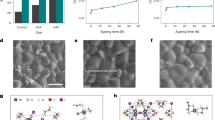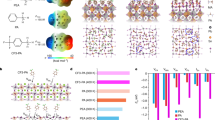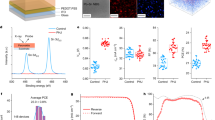Abstract
All-perovskite tandem solar cells are promising as next-generation high-efficiency photovoltaic devices. However, further progress in tin-lead (Sn–Pb) mixed perovskites, which are essential as the narrow-bandgap bottom sub-cell, is hampered by unbalanced crystallization processes, leading to inhomogeneous films and reduced power conversion efficiency (PCE). Here we provide a complete understanding of the formation of Sn–Pb films, from the precursor solution to the final film. We find that the total crystallization barrier for Sn-based perovskites is limited by the desorption of dimethyl sulfoxide (DMSO), while Pb-based perovskites experience a smaller DMSO desorption barrier. By engineering the reaction barrier in mixed films via tailoring the DMSO content, we obtain synchronous Sn–Pb perovskite crystallization and high-quality homogeneous films. On the basis of this understanding, we demonstrate single-junction Sn–Pb perovskite solar cells with a PCE of 22.88% and all-perovskite tandem devices with a certified PCE of 28.87%, fabricated by antisolvent-free methods. The unencapsulated tandem devices retain 87% of their initial PCE after about 450 h with maximum power point tracking under 1 sun illumination.
This is a preview of subscription content, access via your institution
Access options
Access Nature and 54 other Nature Portfolio journals
Get Nature+, our best-value online-access subscription
$32.99 / 30 days
cancel any time
Subscribe to this journal
Receive 12 print issues and online access
$259.00 per year
only $21.58 per issue
Buy this article
- Purchase on SpringerLink
- Instant access to full article PDF
Prices may be subject to local taxes which are calculated during checkout




Similar content being viewed by others
Data availability
All data are available in the main text or Supplementary Information. The data are available from the corresponding authors upon reasonable request.
References
Eperon, G. E. et al. Perovskite–perovskite tandem photovoltaics with optimized band gaps. Science 354, 861–865 (2016).
Lin, R. et al. Monolithic all-perovskite tandem solar cells with 24.8% efficiency exploiting comproportionation to suppress Sn(II) oxidation in precursor ink. Nat. Energy 4, 864–873 (2019).
Lin, R. et al. All-perovskite tandem solar cells with improved grain surface passivation. Nature 603, 73–78 (2022).
Xiao, K. et al. Scalable processing for realizing 21.7%-efficient all-perovskite tandem solar modules. Science 376, 762–767 (2022).
He, R. et al. Improving interface quality for 1 cm2 all-perovskite tandem solar cells. Nature 618, 80–86 (2023).
Chen, H. et al. Regulating surface potential maximizes voltage in all-perovskite tandems. Nature 613, 676–681 (2023).
Green, M. A. et al. Solar cell efficiency tables (version 64). Prog. Photovolt. Res. Appl. 32, 425–441 (2024).
Zhao, D. et al. Low-bandgap mixed tin-lead iodide perovskite absorbers with long carrier lifetimes for all-perovskite tandem solar cells. Nat. Energy 2, 17018 (2017).
Zhao, D. et al. Efficient two-terminal all-perovskite tandem solar cells enabled by high-quality low-bandgap absorber layers. Nat. Energy 3, 1093–1100 (2018).
Liao, W. et al. Lead-free inverted planar formamidinium tin triiodide perovskite solar cells achieving power conversion efficiencies up to 6.22%. Adv. Mater. 28, 9333–9340 (2016).
Yu, D. et al. Electron-withdrawing organic ligand for high-efficiency all-perovskite tandem solar cells. Nat. Energy 9, 298–307 (2024).
Lin, R. et al. All-perovskite tandem solar cells with 3D/3D bilayer perovskite heterojunction. Nature 620, 994–1000 (2023).
Xiao, K. et al. All-perovskite tandem solar cells with 24.2% certified efficiency and area over 1 cm2 using surface-anchoring zwitterionic antioxidant. Nat. Energy 5, 870–880 (2020).
Tong, J. et al. Carrier lifetimes of >1 μs in Sn-Pb perovskites enable efficient all-perovskite tandem solar cells. Science 364, 475–479 (2019).
Hu, S. et al. Optimized carrier extraction at interfaces for 23.6% efficient tin-lead perovskite solar cells. Energy Environ. Sci. 15, 2096–2107 (2022).
Chen, H. et al. Improved charge extraction in inverted perovskite solar cells with dual-site-binding ligands. Science 384, 189–193 (2024).
Li, B. et al. Tin-based defects and passivation strategies in tin-related perovskite solar cells. ACS Energy Lett. 5, 3752–3772 (2020).
Ke, W., Stoumpos, C. C. & Kanatzidis, M. G. “Unleaded” perovskites: status quo and future prospects of tin-based perovskite solar cells. Adv. Mater. 31, e1803230 (2019).
Li, C. et al. Low-bandgap mixed tin-lead iodide perovskites with reduced methylammonium for simultaneous enhancement of solar cell efficiency and stability. Nat. Energy 5, 768–776 (2020).
Hu, S. et al. Narrow bandgap metal halide perovskites for all-perovskite tandem photovoltaics. Chem. Rev. 124, 4079–4123 (2024).
Gao, H. et al. Homogeneous crystallization and buried interface passivation for perovskite tandem solar modules. Science 383, 855–859 (2024).
Ternes, S., Laufer, F. & Paetzold, U. W. Modeling and fundamental dynamics of vacuum, gas, and antisolvent quenching for scalable perovskite processes. Adv. Sci. 11, e2308901 (2024).
Li, C. et al. Vertically aligned 2D/3D Pb-Sn perovskites with enhanced charge extraction and suppressed phase segregation for efficient printable solar cells. ACS Energy Lett. 5, 1386–1395 (2020).
Li, X. et al. A vacuum flash-assisted solution process for high-efficiency large-area perovskite solar cells. Science 353, 58–62 (2016).
Abdollahi Nejand, B. et al. Scalable two-terminal all-perovskite tandem solar modules with a 19.1% efficiency. Nat. Energy 7, 620–630 (2022).
Dai, X. et al. Efficient monolithic all-perovskite tandem solar modules with small cell-to-module derate. Nat. Energy 7, 923–931 (2022).
Xiao, Q. et al. Intermediate phase formation and its manipulation for vacuum-assisted blade-coated wide-bandgap perovskite. Sol. RRL 7, 2300486 (2023).
Liang, K., Mitzi, D. B. & Prikas, M. T. Synthesis and characterization of organic-inorganic perovskite thin films prepared using a versatile two-step dipping technique. Chem. Mater. 10, 403–411 (1998).
Yeom, K. W., Lee, D. K. & Park, N. G. Hard and soft acid and base (HSAB) engineering for efficient and stable Sn-Pb perovskite solar cells. Adv. Energy Mater. 12, 2202496 (2022).
Liu, H. et al. Modulated crystallization and reduced VOC deficit of mixed lead-tin perovskite solar cells with antioxidant caffeic acid. ACS Energy Lett. 6, 2907–2916 (2021).
He, D. et al. Accelerated redox reactions enable stable tin-lead mixed perovskite solar cells. Angew. Chem. Int. Ed. Engl. 63, e202317446 (2024).
Sun, N. et al. Architecture of p-i-n Sn-based perovskite solar cells: characteristics, advances, and perspectives. ACS Energy Lett. 6, 2863–2875 (2021).
Dong, H. et al. Crystallization dynamics of Sn-based perovskite thin films: toward efficient and stable photovoltaic devices. Adv. Energy Mater. 12, 2102213 (2022).
Jiang, X. et al. One-step synthesis of SnI2·(DMSO)x adducts for high-performance tin perovskite solar cells. J. Am. Chem. Soc. 143, 10970–10976 (2021).
Hao, F. et al. Solvent-mediated crystallization of CH3NH3SnI3 films for heterojunction depleted perovskite solar cells. J. Am. Chem. Soc. 137, 11445–11452 (2015).
Li, Y. et al. Boosting CsSnI3-based near-infrared perovskite light-emitting diodes performance via solvent coordination engineering. InfoMat 6, e12537 (2024).
Huang, L.-Y. & Lambrecht, W. R. L. Electronic band structure trends of perovskite halides: Beyond Pb and Sn to Ge and Si. Phys. Rev. B 93, 195211 (2016).
Yuan, Q. Q. et al. Direct growth of van der Waals tin diiodide monolayers. Adv. Sci. 8, e2100009 (2021).
Cao, J. et al. Identifying the molecular structures of intermediates for optimizing the fabrication of high-quality perovskite films. J. Am. Chem. Soc. 138, 9919–9926 (2016).
Chen, G.-Y., Guo, Z.-D., Gong, X.-G. & Yin, W.-J. Kinetic pathway of γ-to-δ phase transition in CsPbI3. Chem 8, 3120–3129 (2022).
Chen, D. et al. Room-temperature direct synthesis of tetragonal β-CsPbI3 nanocrystals. Adv. Opt. Mater. 10, 2101869 (2021).
Chen, C. et al. Efficiency improvement of Sb2Se3 solar cells via grain boundary inversion. ACS Energy Lett. 3, 2335–2341 (2018).
Wang, J. et al. Enhancing photostability of Sn-Pb perovskite solar cells by an alkylammonium Pseudo-Halogen additive. Adv. Energy Mater. 13, 2204115 (2023).
Abdollahi Nejand, B. et al. Vacuum-assisted growth of low-bandgap thin films (FA0.8MA0.2Sn0.5Pb0.5I3) for all-perovskite tandem solar cells. Adv. Energy Mater. 10, 1902583 (2020).
Li, C. et al. Diamine chelates for increased stability in mixed Sn–Pb and all-perovskite tandem solar cells. Nat. Energy https://doi.org/10.1038/s41560-41024-01613-41568 (2024).
Acknowledgements
All work was supported by the National Natural Science Foundation of China (62134003 to J.T. and 62174064 to C.C.), the Major State Basic Research Development Program of China (2023YFB3608900 to J.T.), Guangdong Provincial Key Laboratory of Manufacturing Equipment Digitization (2023B1212060012 to C.C.), the Innovation Project of Optics Valley Laboratory (OVL2024ZD002 to C.C. and OVL2021BG008 to J.T.), Fundamental Research Funds for the Central Universities (2021XXJS028 to C.C.), the Innovation Fund of WNLO and the National Natural Science Foundation of China/Research Grants Council of Hong Kong Joint Research Scheme (22361162608 to A.L.). We also appreciate measurement support from Die & Mould Technology, the Analytical and Testing Center of Huazhong University of Science and Technology, the open and Shared Service Platform for Large Instruments and Equipment of School of Optical and Electronic Information of Huazhong University of Science and Technology and the Center for Nanoscale Characterization & Devices (CNCD), WNLO-HUST for facility access.
Author information
Authors and Affiliations
Contributions
J.T., C.C. and H.S. conceived the idea and directed the overall project. X.Y. and T.M. fabricated all the devices and conducted the characterizations. A.Z., C.G. and M.L. helped to set up laboratory equipment and optimize the vacuum-assisted devices. H.H. and X.L. participated in the discussion and performed thermogravimetric analysis measurement. S.Y. performed maximum power point tracking measurements. W.Y., Y.Z. and J.Y. helped to fabricate and optimize Sn–Pb perovskite film. Z.L. and X.S developed the synthesis of 4PADCB. Y.Z. helped to discuss and analyse data. X.Y., C.C. and J.T. wrote the manuscript with the help of T.M. All authors discussed the results and commented on the paper.
Corresponding authors
Ethics declarations
Competing interests
The authors declare that they have no competing interests.
Peer review
Peer review information
Nature Photonics thanks Yinghuan Kuang, Michael Saliba and Hairen Tan for their contribution to the peer review of this work.
Additional information
Publisher’s note Springer Nature remains neutral with regard to jurisdictional claims in published maps and institutional affiliations.
Supplementary information
Supplementary Information
Supplementary Note 1, Figs. 1–37, Tables 1–4 and References.
Rights and permissions
Springer Nature or its licensor (e.g. a society or other partner) holds exclusive rights to this article under a publishing agreement with the author(s) or other rightsholder(s); author self-archiving of the accepted manuscript version of this article is solely governed by the terms of such publishing agreement and applicable law.
About this article
Cite this article
Yang, X., Ma, T., Hu, H. et al. Understanding and manipulating the crystallization of Sn–Pb perovskites for efficient all-perovskite tandem solar cells. Nat. Photon. 19, 426–433 (2025). https://doi.org/10.1038/s41566-025-01616-1
Received:
Accepted:
Published:
Issue date:
DOI: https://doi.org/10.1038/s41566-025-01616-1
This article is cited by
-
Solvent engineering enables tin-lead perovskite films with long carrier diffusion lengths and reduced tin segregation
Nature Communications (2025)
-
Lattice stabilization and strain homogenization in Sn-Pb bottom subcells enable stable all-perovskite tandems solar cells
Nature Communications (2025)
-
Achieving efficient all-perovskite tandem solar cells through the modulation of crystallization in Sn-Pb perovskite solar cells
Science China Chemistry (2025)



